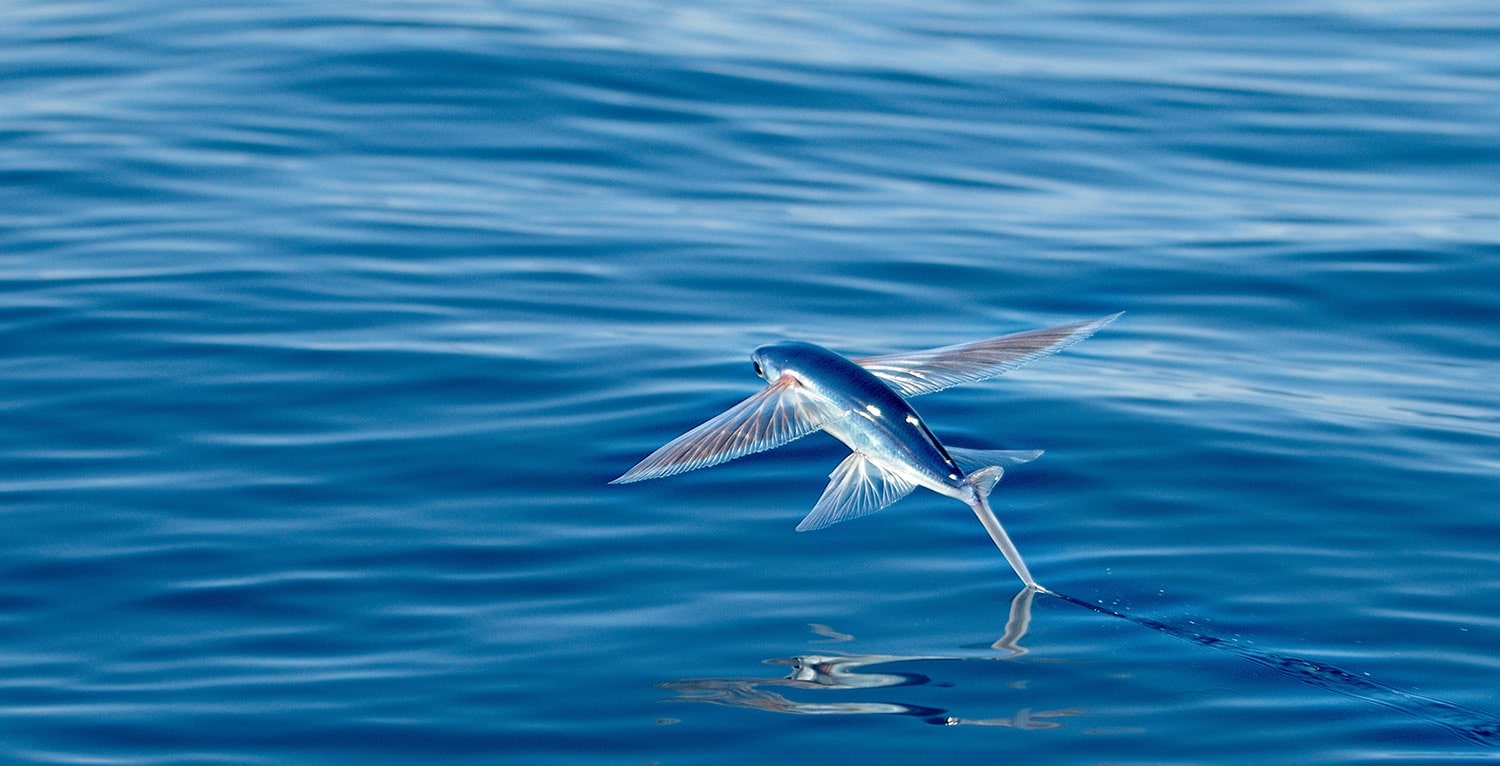
37 interesting facts about flying fish
- 👁️ 366
Flying fish, those fascinating creatures of the sea, blur the lines between the aquatic and aerial worlds with their remarkable ability to glide above the water’s surface. Belonging to the family Exocoetidae, these fish have evolved unique adaptations that allow them to escape predators by leaping into the air and “flying” for considerable distances. Flying fish inhabit all the oceans, particularly in warm tropical and subtropical waters. Their ability to glide through the air, combined with their streamlined bodies and wing-like fins, make them one of nature’s most intriguing marvels. Let’s dive into some interesting and informative facts about flying fish that showcase their uniqueness, behavior, and the role they play in their ecosystems.
- Flying fish can glide over the water for distances of up to 400 meters (1,300 feet).
- They achieve flight by rapidly flapping their tail while their elongated pectoral fins are spread wide.
- The world’s oceans are home to about 64 species of flying fish.
- These fish belong to the Exocoetidae family, which is derived from the Greek “exocoetus,” meaning “sleeping outside,” a reference to their habit of stranding themselves on boats.
- Flying fish can reach speeds of up to 60 km/h (37 mph) when gliding.
- Their flights are typically around 30 seconds long, but some have been observed gliding for up to 45 seconds.
- Flying fish are known to leap out of the water to escape predators such as tuna, marlin, and dolphins.
- They are predominantly found in the open ocean, where their gliding ability is most advantageous for evading threats.
- Some species of flying fish can make consecutive glides, re-entering the water to gain momentum before taking off again.
- The largest species of flying fish can grow up to 45 cm (18 inches) in length.
- At night, flying fish are attracted to light, which fishermen use to their advantage by illuminating the water to catch them.
- The roe of flying fish is considered a delicacy in some cultures, particularly in Japanese cuisine.
- Flying fish do not actually fly in the same way birds do; their flight is more accurately described as gliding through the air.
- They primarily feed on plankton and are, in turn, a significant source of food for larger marine predators.
- Despite their name, flying fish are not capable of powered flight like birds; their “flights” are essentially long, controlled glides.
- The evolutionary ancestors of flying fish are thought to have first appeared in the Middle Miocene, around 15 million years ago.
- Flying fish lay their eggs in floating masses of sargassum seaweed, where they find protection and food upon hatching.
- The Barbados Flying Fish Festival is held annually to celebrate this iconic fish, which is also an emblem of the country’s national identity.
- Flying fish have been observed reaching heights of up to 6 meters (20 feet) above the surface of the water.
- Their bodies are streamlined for minimal drag, allowing for faster speeds both underwater and in the air.
- The record for the longest glide by a flying fish is held by a specimen that covered a distance of 45 meters (148 feet) in 42 seconds.
- Predation by seabirds is a common threat to flying fish when they are airborne.
- Some species of flying fish have both pectoral and pelvic fins elongated for improved gliding capability.
- The ability to glide is developed in flying fish from a young age to evade oceanic predators.
- Flying fish eggs are coated with a sticky substance that adheres to floating debris and seaweed for safety.
- In some regions, flying fish are caught using nets specifically designed to capture them during their gliding flights.
- The eyes of flying fish are positioned on the sides of their heads, providing a wide field of vision essential for spotting predators from the air and water.
- Besides being consumed by humans, flying fish are also used as bait in the fishing industry.
- Climate change and rising ocean temperatures could potentially impact the habitats and migration patterns of flying fish.
- Flying fish have been featured in the folklore and mythology of various cultures, often symbolizing freedom and agility.
- The fossil record of flying fish includes specimens that date back to the Eocene epoch, approximately 50 million years ago.
- Despite their name and ability to glide, flying fish are incapable of sustained flight or flapping their fins in the air like wings.
- Their unique method of locomotion has inspired technological innovations and designs in the field of biomimicry.
- The pectoral fins of flying fish, used for gliding, are among the largest in proportion to body size of any fish.
- In order to take flight, flying fish first gain velocity underwater before breaking the surface and extending their fins.
- The scales of flying fish are embedded in their skin, reducing friction and aiding in their swift movements through water.
- While airborne, flying fish can make directional changes by tilting their tail fins.
Flying fish are a remarkable testament to the adaptability and diversity of life in the marine environment. Their unique mode of locomotion allows them not only to escape predators but also to captivate the human imagination. As we continue to learn about these fascinating creatures, we gain a greater appreciation for the wonders of the natural world and the intricate ecosystems of our oceans. The study of flying fish not only enriches our understanding of evolutionary biology but also underscores the importance of conserving the delicate balance of marine habitats for future generations.
Flying fish, those fascinating creatures of the sea, blur the lines between the aquatic and aerial worlds with their remarkable ability to glide above the water’s surface. Belonging to the family Exocoetidae, these fish have evolved unique adaptations that allow them to escape predators by leaping into the air and…